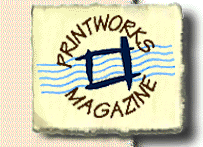The change to direct emulsion has finally permeated all
sectors of the fine art screenprinting arena. A few enlight-ened individuals, and
institutions such as the Royal College of Art, have used these products for many years,
but for most of us the change from films such as Five Star and Novastar has been slow and
painful.
This reluctance is not surprising given the need for
purpose built print-ing down frames, drying cupboards that are lightfast and preferably a
quartz halide light source. The long term benefits for art schools and workshops are the
markedly lower costs of these products and the safer chemicals used in the processing.
Which brand of the different types to use is a matter of personal preference: I mainly use
Folex Dc500 only because I keep stencils on screens for long periods and find this
emulsion will decoat easily under such circumstances. The emulsions come in three
different forms.
1. Dichromates (e.g. Seriset) are the
original direct emulsions. They are very cheap to use but have distinct health and safety
disadvantages. The dichromate used in their manufacture is not very biodegradable, and
they need the use of bleach or other strong alkaline solutions to decoat them from the
screen. They have a very short shelf life once mixed.
2. Diazo-based (e.g. Folex Dc200,
Seri-col, Kiwicol Poly plus W.) come in two parts: the emulsion and a sensitiser. They
have a very wide exposure lati-tude, and the dual cure versions can be used for both
solvent- and water-based inks. The only problem is their rela-tively short shelf life once
mixed; this can be increased by keeping mixed emulsions in a domestic refrigerator, they
then last approximately two to three months. These products are decoated with chemicals
that are much less harmful, much easier to use and do not cause the same health and
environ-mental problems.
3. One pot emulsions, sometimes known as
SBQ (e.g. Folex Dc500, Seri-col). These are the latest generation of emulsions that, in
performance terms for most printmaking, show little differ-ence from the diazo-based
products; a certain crispness of line perhaps. Their advantage lies in an extended shelf
life: they will keep for long periods without showing signs of thickening. They are
decoated with the same chemicals as the diazo products. The minus side seems to be that
they prefer correct exposure periods, so any under or over exposure can result in a
stencil that remains slightly tacky, causing news-print to stick to them whilst blotting.
There are golden rules to using emulsions. Ensure the
coating trough is spotlessly clean with no nicks or notches especially the blade (the back
edge of the blade particularly) with no traces of residue or dried emulsion. Keep the lid
on the pot tightly and ideally keep it in a refrigerator to make sure there are no hard
lumps or thickening of the emulsion. Make sure the screens are properly and tightly
stretched before coating to ensure you use the minimum amount of emulsion; one coat with
spotting out is adequate for most circumstances. Most importantly always force dry screens
with heat. In California they prop screens against a wall in the darkroom to dry
naturally, but due to the relative humidity as the screens dry, they trap a layer of
mois-ture droplets inside the emulsion. When the screens are exposed, the moisture
droplets scatter the light caus-ing very poor stencils. It shocked us to find that this
lack of force drying com-bined with the absence of an integrator (a light source
controlled by a photo electric cell to read light density) meant that they could not
produce high definition stencils.
As water-based ink can go through much finer meshed
screens, it is now possible to print very fine detail. This is the main feature of
water-based screen- prints in the UK. The best water-based filler we have found so far is
Marler Aquafil, a green water-based filler that washes out easily when the stencil is
decoated.
Contact: Steve Hoskins, University of the West of England,
Clanage Road, Bower Ashton, Bristol BS3 2JT, UK
Email S2-Hoski@UWE.AC.UK. or Tel: +44 (0)117
9660222 ext 4704.
 The information resource
for printmakers
The information resource
for printmakers  The information resource
for printmakers
The information resource
for printmakers